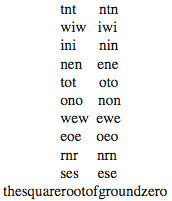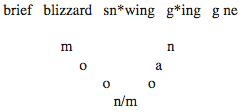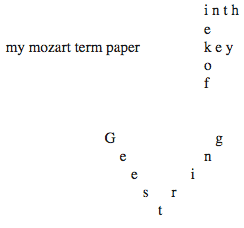Raffael de Gruttola & Carlos Colόn
Wall Street Park: A Concrete Renku
Raffael de Gruttola & Carlos Colόn. Wall Street Park: A Concrete Renku. Upton, Massachusetts: piXeLaRt Press, 2007, 16 pages, 8.5 x 11 inches. $8.00 postpaid from Carlos Colόn, 185 Lynn Avenue, Shreveport, LA 71105-3523 USA, or from Raffael de Gruttola, 4 Marshall Road, Natick, MA 01760 USA.
By Michael Dylan Welch, Washington
I’ve just had the pleasure of reading Wall Street Park, by Raffael de Gruttola and Carlos Colón. It’s an entertaining, passionate, and inventive “concrete renku,” a 36-verse collaboration using concrete poems instead of haiku. Of course, this is not their first go at this, as this book follows Circling Bats, published in 2001, which I believe to be the first concrete renku ever written. And they’ve done it again. Starting with a verse written about Wall Street the day after September 11, it’s no wonder that the twin towers should appear in the second verse, by Carlos:

It took them almost four years to complete this new collaboration, finishing in July of 2004. After an insightful introduction by Nick Avis (himself an afficionado of both concrete poetry and haiku), Wall Street Park weaves together the playful and profound, as in the first poem here by Carlos, the second by Raffael:

A serendipity to this collection is a four-page insert, written three years after the renku, in which the authors explicate their influences, their verses, and the links between them. In these notes, Carlos reminds us of his indebtedness, in his verse above, to Marlene Mountain’s “sn wfl k” and Raffael points out that the autumn moon (here in its traditional position as fifth verse in the renku) signifies waning and the beginning of decay and death.
The renku includes cultural references such as Carlos’s use of “unhalfbricking,” the title of an album by 60s band Fairport Convention, followed by Raffael’s reference to a Cirque du Soleil show. Inventions include Raffael’s transposing of “wabi sabi num lock” from roman text to a font that presents only symbols in place of letters, in this case symbols of sport and transport, following, as it does, after Carlos’s brilliant triangular traffic sign that spells the word “EGO” vertically under the middle of the word “YIELD.” Other verses include shapes and graphics, an I Ching hexagram, a maze, and various fonts in various point sizes. Some verses are just text, some even just conventional haiku-like poems, although usually with at least some concrete aspect. Another (by Carlos), within a single verse, presents three upside-down question marks hung on a diagonal string or line next to the following text, creating a haiga-like effect:
for a moment
the setting sun rides
a ski lift
Links between verses range from the two enlarged vowels at the end of “ballOOn” being echoed by “ee” of “peeper” with eyes drawn in the letters, to the criss-crossing of a DNA helix in one verse morphing into a large letter “X” marking the spot of gold released from the earth. For the most part, the links between verses are not so obvious as these examples, which makes the insert helpful, but here’s another pair of favourites (first by Carlos, then by Raffael) where the link is clear:

The way I read this inventive book, which stretches the possibilities for renku, was to just read the verses individually the first time. Then I read them again, looking for the links between the verses, whether a repetition of shape or a tonal echo, or sometimes a contrast. Then I read it again, reading the notes about each verse. Each reading brought fresh insights and admiration, and some verses revealed slightly hidden meanings by this process.
Traditional renku, of course, is a highly social art form, and so often the finished results can be tedious to read, even if you were a participant yourself. Not so with this renku, which unfolded in new and surprising ways, and rewarded multiple readings. As Marlene Mountain proclaims of Wall Street Park on the back cover, “It’s a wonderful book. Just look at it.” I’ll leave you with the following additional favorite, by Carlos:
j
e u
s d
u a
s
i
l
v
e
r
l i n i n g
![]()
